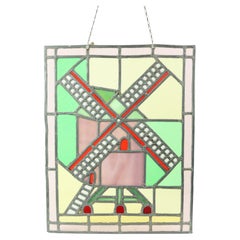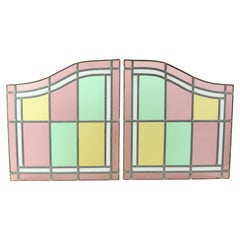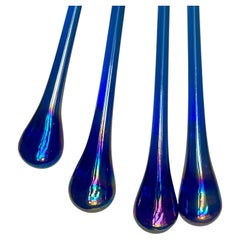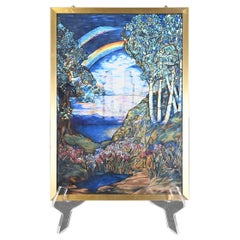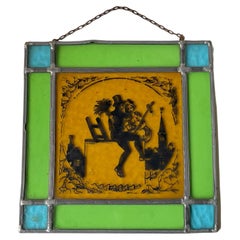Vintage Glass Suncatcher
Vintage Stained Glass Window Mill Stained Glass Suncatcher 47x37cm
Located in Poperinge, BE
Beautiful old stained glass window, stained glass with an image of a mill, with bright colors
Category
1970s Belgian Vintage Glass Suncatcher
Materials
Lead
Holmegaard Michael Bang Blue Glass Noahs Arc Suncatcher
By Holmegaard, Michael Bang
Located in Bolton, GB
A stunning Scandinavian blue glass suncatcher. Made by Holmegaard of Denmark and designed by
Category
1960s Danish Mid-Century Modern Vintage Glass Suncatcher
Materials
Glass, Art Glass, Blown Glass
Vintage Stained Glass Window Stained Glass Set of 2 Classic Style 92x50cm
Located in Poperinge, BE
Beautiful set of 2 old stained glass windows, stained glass suncatchers, completely in classical
Category
1930s Belgian Art Deco Vintage Glass Suncatcher
Materials
Lead
H 19.69 in W 36.23 in D 0.4 in
Vintage Leaded Stained Glass Red and Blue Parrot Bird Window Suncatcher - a Pair
Located in Philadelphia, PA
Vintage Leaded Stained Glass Red and Blue Parrot Bird Window Suncatchers - a Pair. Circa Late 20th
Category
Late 20th Century Art Deco Vintage Glass Suncatcher
Materials
Glass
H 33 in W 21.75 in D 0.25 in
Midcentury Teardrop Sun Catchers in Blue Rainbow Glass, Set of 4
Located in Esbjerg, DK
A set of 4 teardrop shaped glass ornaments or suncatchers in irredesent cobalt blue glass. Unknown
Category
1970s Scandinavian Mid-Century Modern Vintage Glass Suncatcher
Materials
Glass
Recent Sales
Louis Comfort Tiffany Double Rainbow Stained Glass Suncatcher
By Tiffany Studios
Located in South Bend, IN
A gorgeous reproduction Louis Comfort Tiffany Art Nouveau stained glass double rainbow suncatcher
Category
Late 20th Century American Art Deco Vintage Glass Suncatcher
Materials
Brass
Danish Folk Art Suncatcher in Stain Glas, H. C. Andersen Motif, 1930s
Located in Esbjerg, DK
A handmade and hand-painted sun catcher in stain glass. Motif H. C. Andersens: The Shepherdess and
Category
1930s Scandinavian Mid-Century Modern Vintage Glass Suncatcher
Materials
Glass
Erik Höglund Suncatcher Dog in Blue Glass, 1970s
By Erik Höglund
Located in Esbjerg, DK
A rare blue dog figurine in hand-thrown glass. It catches and reflects light and the sun so
Category
1970s Swedish Scandinavian Modern Vintage Glass Suncatcher
Materials
Blown Glass
Large Danish Modern Iron Floor Sculpture with Holmegaard Suncatcher, 1960s
By Holm Sørensen
Located in Odense, DK
suncatcher in thick handblown glass by Holmegaard Glasvaerk, Copenhagen. This piece of Brutalist Art was made
Category
1960s Danish Scandinavian Modern Vintage Glass Suncatcher
Materials
Wrought Iron
H 26.78 in W 13 in D 3.94 in
Get Updated with New Arrivals
Save "Vintage Glass Suncatcher", and we’ll notify you when there are new listings in this category.
Questions About Vintage Glass Suncatcher
- 1stDibs ExpertNovember 4, 2024To identify vintage glass, you will need to figure out if your item is between 20 and 99 years old. The easiest way to do so is first to determine the maker by looking for and then researching any markings present on the glassware. Unfortunately, vintage glass is often marked with paper and foil labels, which tend to come loose with use. As a result, experience and expertise are often necessary to accurately perform the identification process, so you may wish to have a certified appraiser or experienced antique dealer weigh in if your glassware is unmarked. Find a diverse assortment of vintage glassware on 1stDibs.
- 1stDibs ExpertSeptember 9, 2024To tell if glass is vintage, first look for a marking that indicates the maker. By researching the manufacturer using trusted online resources, you can learn when it produced pieces similar to yours and get a rough idea of your glassware's age. Any glass produced between 20 and 99 years ago is vintage. If you need assistance with the dating process, seek the opinion of a certified appraiser or knowledgeable antique dealer. Explore a diverse assortment of vintage glassware on 1stDibs.
- 1stDibs ExpertAugust 8, 2024To tell if glass is vintage, first look for markings, often located on the bottom or inside of glassware. By researching the mark via online resources, you can determine the maker and learn more about your piece. Any glassware produced between 20 and 100 years ago qualifies as vintage, while older pieces are antique. In the event that you can't find any markings, a certified appraiser or knowledgeable antiques dealer can assist you. Find a wide variety of vintage glassware on 1stDibs.
- What is vintage slag glass?1 Answer1stDibs ExpertApril 5, 2022Slag glass is pressed opaque glass that has colored streaks throughout. It was used in everything from lamp shades to decorative bowls. On 1stDibs, you can find a collection of authentic slag glass pieces from some of the world’s top sellers.
- 1stDibs ExpertAugust 20, 2024To tell if a glass vase is vintage, first research the maker. Look for markings on the inside and base, and then research them using trusted online resources to determine who produced your vase. By looking at when the maker was active and producing pieces similar to yours, you can typically roughly estimate its age. If your vase is between 20 and 99 years old, it is vintage. Vases that are 100 years old or older are antiques. For help with dating, consult a certified appraiser or knowledgeable antique dealer. On 1stDibs, find a collection of glass vases.
- Is vintage glass worth anything?1 Answer1stDibs ExpertSeptember 16, 2024Yes, some vintage glass is worth something. Collectors are often on the hunt for pieces produced by certain makers, such as Blenko, the Culver Glass Company, Dorothy Thorpe, Libbey, Georges Briard and Arcoroc. In addition to who manufactured it, the style, type, age and condition of vintage glassware all impact the potential value. For assistance with the valuation process for pieces in your collection, enlist the help of a certified appraiser or knowledgeable antique dealer. On 1stDibs, find a diverse assortment of vintage glassware.
- 1stDibs ExpertOctober 24, 2024To tell if your vintage glasses are gold, look on the nose bridge and the temples for a purity mark. Makers often stamped their solid gold pieces with “12K,” “10K,” “14K” and other markings to identify their gold eyewear. You can research all of these markings using trusted online resources. Should you locate a "GF" mark, it is likely that your glasses are gold-filled rather than solid gold. This means that the frames are predominantly a less expensive metal but do have a thin layer of genuine gold alloy as a finish. Another mark that indicates your glasses contain some gold is "RGF." The mark stands for “rolled gold filled.” Glasses bearing this mark feature a gold-plated finish that is thinner than what's found on traditional gold-filled frames. For assistance identifying your eyeglass frame material, consult a certified appraiser or experienced antique dealer. Explore a selection of vintage glasses on 1stDibs.
- 1stDibs ExpertAugust 29, 2024To tell if Murano glass is vintage, it's usually necessary to conduct some online research using trusted sources. Start by looking for a maker's mark and then cross-referencing it with images published online to determine who made your piece. By learning more about the manufacturer and what they produced over the years by reading histories and exploring product catalogues, you can estimate the rough age of your piece. For Murano glass to be considered vintage, it must be between 20 and 99 years old. Older pieces are classified as antique. If you need assistance with dating your glassware, seek the help of a certified appraiser or knowledgeable antique dealer. Explore a range of Murano glass on 1stDibs.
- 1stDibs ExpertNovember 2, 2023To tell if vintage Cartier glasses are real, first look for the brand's logo on the outside of the arms. It should be spelled correctly and in the French luxury fashion house's iconic gold-toned italic font. Because some vintage pieces may lack serial numbers and other markings used to identify contemporary eyewear, you may wish to enlist the help of a licensed appraiser or knowledgeable dealer for assistance with authentication. Explore a selection of Cartier glasses on 1stDibs.
- 1stDibs ExpertApril 5, 2022The easiest way to tell if a bead is glass or plastic is to feel it. Glass beads will be cooler to the touch, whereas plastic beads will be closer to room temperature and warm up quickly in your hands. Another test you can perform is to listen to the sound. Glass has a distinctive ring since it’s harder whereas plastic is softer and has a duller sound. Shop a range of vintage glass bead pieces on 1stDibs.
